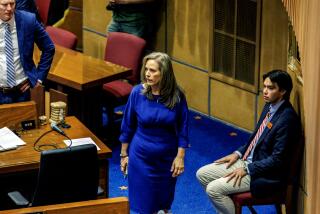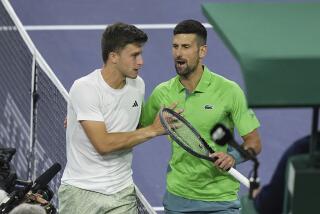Davenport Gets Back on Feet at Scottsdale
- Share via
INDIAN WELLS — You might say Lindsay Davenport celebrated her Australian Open title on ice.
Make that in ice.
After Davenport won in Melbourne--not losing a set in seven matches-- she had to pull out of an event in Tokyo because of a sore left hamstring and groin. The pain started bothering her toward the end of the Australian Open, but she was able to play through it.
Once she returned home to Southern California, the leg felt worse and she had limited training for nearly a month. Davenport returned to the tour at Scottsdale, Ariz., the event right before the Indian Wells Tennis Masters Series.
“It got much better after I got to Scottsdale,” she said. “The whole month I was home, it wasn’t good. It took forever to get better. I couldn’t really train or run at home.”
Luckily for Davenport, the injury did not happen at a crucial time. The women’s tour was in Europe, at indoor events, and she wasn’t going to play in any of those. Last year, she was sidelined at almost the same time because of a nagging respiratory ailment. But that lingered much longer and Davenport came to Indian Wells still ailing, and lost to eventual champion Serena Williams in the second round.
This year, she was able to play some matches under difficult conditions at Scottsdale, defeating Jennifer Capriati, Monica Seles and Anna Kournikova. Bad weather canceled the scheduled final between Davenport and Martina Hingis.
“It was good to come back like that and play,” Davenport said. “The first match, it was so cold when I played Capriati, it had to be high 40s, low 50s.”
Davenport was not too upset about skipping the final after sitting around and waiting for two days.
“You kind of had the sense it was going to be a downer if we played anyway,” she said. “There was nobody there. The high temperature was 50, 52 degrees. The forecast was pretty ominous. Mentally, I was like, ‘Oh, we’re not going to play.’
“It was a weird day. If you had one little break, we were going to start. But they wanted us out of there. Neither one of us wanted to play after it got to a certain point. The interest was kind of gone already.”
GARDEN NOTES
* The prize money for the women’s event increased about 53% from last year--to $2 million from $1.3 million. The winner will receive $330,000, up from $200,000. The losing finalist will earn $160,000, up from $86,000.
* The first main-draw match on the new stadium court ended with an injury. Tara Snyder was leading, 6-2, 4-1, when Amelie Cocheteux retired because of a pulled right hamstring.
* Television coverage of the event begins Monday on ESPN. Early-round coverage will be on ESPN and ESPN2. Fox will show the women’s final Saturday on tape delay, and the men’s final on Fox is live next Sunday, starting at noon.
QUOTE, UNQUOTE
* “I never thought I’d be in the top 10. I’m not strong and powerful.”
Dominique Van Roost of Belgium, who was as high as No. 9 in late 1998.
* “[Jiri] Novak only likes to practice for one day.”
Czech Republic Davis Cup captain Jan Kukal, before Novak led the team to a 4-1 victory over Britain in the first round.
* “The difference between me in the Copenhagen final in 1992 is eight years. I don’t serve as well as I did back then, and my legs are more tired.”
Magnus Larsson, after reaching the final again.
STINGS LIKE A BEE
Rising star Juan Carlos Ferrero of Spain has a couple of nicknames, and, oddly enough, “King” isn’t one of them. The other players on the tour call him “Mosquito.”
“They gave it to me last year in Germany because my legs are so fast like a mosquito,” Ferrero said, laughing.
He prefers another nickname, “Chavalito,” which means little kid.
You might say that Ferrero, who turned 20 last month, is part of the junior Armada, the next wave of young Spaniards. His improvement has been rapid. At the start of 1999, he was 345th in the world. Now, he is closing in on the top 20.
The Spanish newspaper El Mundo wrote that his forehand was almost “as scary as [Andre] Agassi’s.” He doesn’t go quite as far but acknowledged that it is his strength, saying: “The best shot for me is the forehand, when I play good.”
He won his first title last year on clay in Mallorca, Spain, defeating Alex Corretja in the final. In 2000, Ferrero has found success on hardcourts, which isn’t overly surprising since he trained on that surface as a youngster in Spain.
Ferrero failed to reach his second final of the year, losing to Lleyton Hewitt in the semifinals, 6-4, 6-2, at Scottsdale, Ariz., on Saturday night. He had advanced by defeating Patrick Rafter in the first round and then knocked off two more of his countrymen, Carlos Moya and Francisco Clavet.
At Indian Wells, Ferrero will play Michael Chang in the first round and is in the same half of the draw as Rafter, Tim Henman, Nicolas Kiefer and Agassi.
More to Read
Go beyond the scoreboard
Get the latest on L.A.'s teams in the daily Sports Report newsletter.
You may occasionally receive promotional content from the Los Angeles Times.











